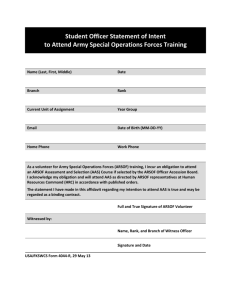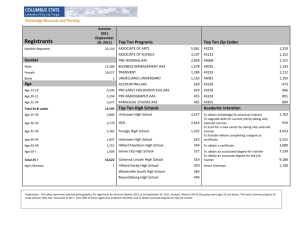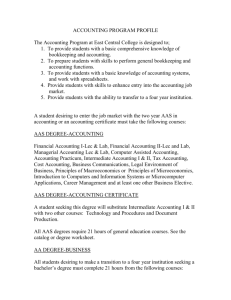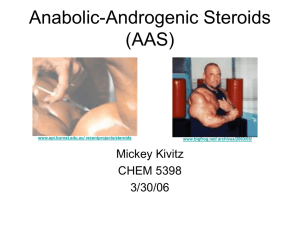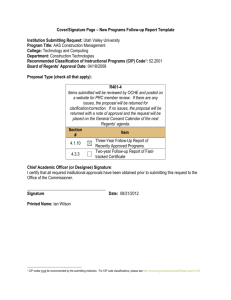Steroids
advertisement
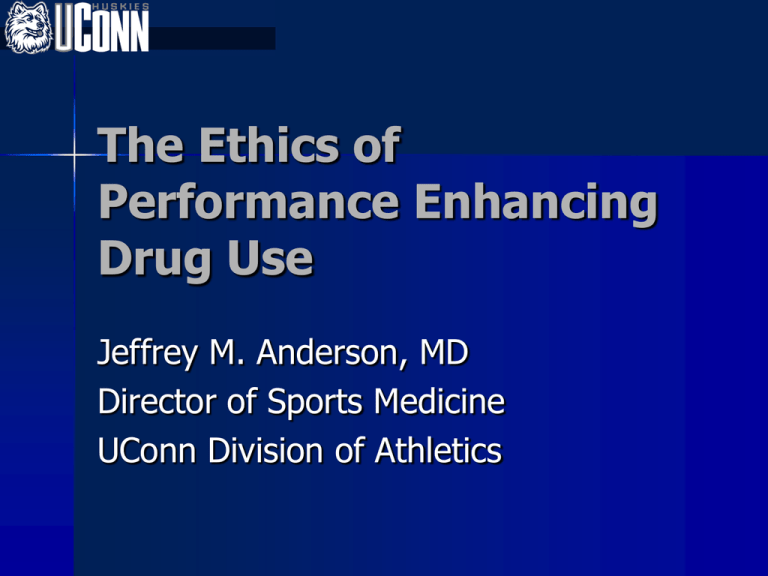
The Ethics of Performance Enhancing Drug Use Jeffrey M. Anderson, MD Director of Sports Medicine UConn Division of Athletics So What Could Possibly Be Wrong With This? Overview Review of anabolic steroid structure/pharmacologic action History of anabolic steroid use in sport Ethical arguments surrounding anabolic steroid use in sport Testosterone Endogenous vs. Exogenous AAS Endogenous – – – – – – Testosterone Androstenedione Androstenediol DHEA 19-norandrosterone 19-noretiocholanolone Exogenous – – – – – – – Nandrolone Norandrostenedione Methandienone Methyltestosterone Stanozolol Boldenone Trenbolone AAS Effects on muscle Most potent stimulators of protein synthesis at the cellular level Effects are noted with supraphysiologic doses (10x-100x) Clearly have a positive effect on muscle growth and hypertrophy History of AAS Brown-Sequard 1889 Zoth and Pregl 1920s Late 30s-testosterone synthesized by German scientists 1950s-Soviet use of testosterone in athletes 1960s-John ZieglerDianabol History of AAS 1960s and 1970srampant use-not illegal or banned 1970s-GDR swimmers Medical establishment still noted no benefit History of AAS 1988-Ben Johnson +stanozolol test 1988-Underground Steroid HandbookDuchaine 1991-Elashoff publishes review in Annals of Internal Medicine stating that no firm conclusion can be drawn on their effects History of AAS 1996-Bhasin-first study documenting anabolic effects of steroids Late 90s-Early 2000s—baseball 2004-US Anabolic Steroid Control Act Side Effects of AAS Hepatic – Liver injury (temporary vs. permanent) – Hepatic tumors Cardiac – Lowered HDL, elevated LDL and triglycerides – Increased thrombogenesis – Cardiomyopathy Genitourinary – Males Impotence Oligospermia/ azoospermia Gynecomastia – Females Clitoromegally Menstrual disturbance Breast atrophy Side Effects of AAS Dermatologic – Acne – Male-pattern baldness – Hirsutism Musculoskeletal – Tendon rupture Side Effects of AAS Psychological – – – – – – Aggressiveness Rage Delirium Depression Psychosis Mania How Common Are Side Effects? No controlled trials Variation in reports depending on perspective Temporary vs. permanent? GDR information is concerning Ethics Autonomy vs. paternalism Unnaturalness? Unfair advantage? Risk of harm? – Personal harm vs. opponents harm vs. societal harm Right to privacy Autonomy – The principle of respect for persons, and of individual self-determination consistent with that principle. As most commonly defined, autonomy points in the direction of personal liberty of action in accordance with a plan chosen only by oneself. Paternalism – Stance that a person’s liberty is justifiably restricted to prevent self-harm, or to promote that person’s own well-being. Paternalism is an inherently libertylimiting principle. It is grounded in a theory of impairment, viz., that an individual lacks sufficient facts or mental capacity to make a sound choice. Unnaturalness AAS are an “unnatural” way to gain advantage Are training, carbohydrate replacement, medications, etc. all “natural”? Unfair Advantage If one athlete uses steroids it gives them an unfair advantage If steroids are not banned, everyone has access Risk of harm Harm to Self – Side effects Harm to Others – What happens to that poor kid on the previous slide? Harm to Society – If one has to use steroids to compete fairly, how many will be forced into using them? Right to privacy Drug testing procedure – Witnessed collection – Complaints of embarrassment – Lack of trust – Invasion of privacy
